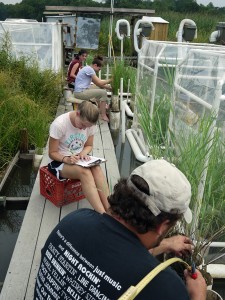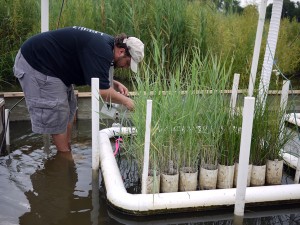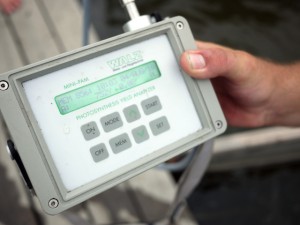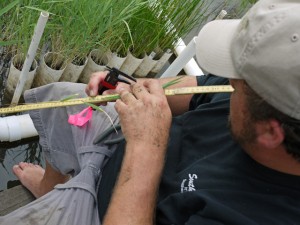
Seal collects data with other interns for Smithsonian scientists who are investigating the impact of global change on tidal marshes.
My name is Matthew Isaiah Seal and I am doing an internship at the Smithsonian Environmental Research Center (SERC) in the Biogeochemistry Laboratory. Having seen both Night at the Museum movies, I wasn’t sure what to expect upon arriving at the Smithsonian to begin my internship. Actually, it was difficult to explain to family what SERC was and how it was part of the Smithsonian. The best explanation I was able to come up with was that SERC is the branch of the Smithsonian that studies the ecology of the Chesapeake Bay and surrounding watersheds. However, I recently learned that the Smithsonian has research sites in Panama and beyond.

While there is no 'typical' day in the field, Seal spends most of his time at SERC working at the Smithsonian's Global Change Research Wetland on the Chesapeake Bay. Photo: Tina Tennessen
I am doing a 26-week internship under senior scientist J. Patrick Megonigal and postdoctoral fellow Thomas Mozdzer. We are working on a global change project that aims to study the tidal marshes of the Chesapeake Bay and how they are changing due to the increasing levels of carbon dioxide and nitrogen from human actions.
I very rarely find myself doing the same thing every day. A few weeks ago I was learning how to use a machine that measures the photosynthesis of plants in one part of the marsh for Adam Langley, another SERC scientist. This week I am helping harvest one of the longest continually running CO2 experiments, which was first started by plant physiologist Bert Drake in the 1980’s. Because of all the variable tasks I am assigned, I am learning critical skills that I will take with me wherever I may work.
The work is not easy and I often find myself in precarious situations. Because we study the marsh, most of our work is conducted outside. This means temperatures regularly exceed 100 degrees Fahrenheit, lifting and carrying heavy equipment and working long days. It can be difficult work and can seem inglorious, which is far different from the work Ben Stiller’s character did.
While I haven’t seen any dinosaurs running through a museum or Sacagawea leading any expeditions, I have seen multitudes of wildlife in the field. The other day I was measuring plant growth in the field when a male bald eagle flew overhead and belted out his distinctive call. I have seen countless red-winged blackbirds, great blue herons, blue crabs, northern water snakes, sea nettles, frogs and toads. Many of these are species I see back home in Mississippi, so I feel like I am in familiar territory.
After work, I retreat to the onsite dorms where I live, which are very convenient because I can walk to work in the morning. I live with people from all over the world, some from Germany and Denmark and some from nearby Virginia and Maryland. Everyone in the dorm works in different labs, so we spend evenings sharing the experiences of our days. Just this evening, I helped count snails for a grad student friend of mine. He was trying to randomize his experiment and he needed help counting and separating them. Also, I usually check in with the “crab lab” to see what I can learn there. There are so many ways an intern can learn during their time here.
I hope to get my work published and I am also earning independent study hours from the University of Southern Mississippi. I am expected to present my research to the staff here at SERC as well as type a paper describing my work. I feel that this internship has put me in a great position to get into graduate school.
— Matthew Isaiah Seal, SERC Intern



